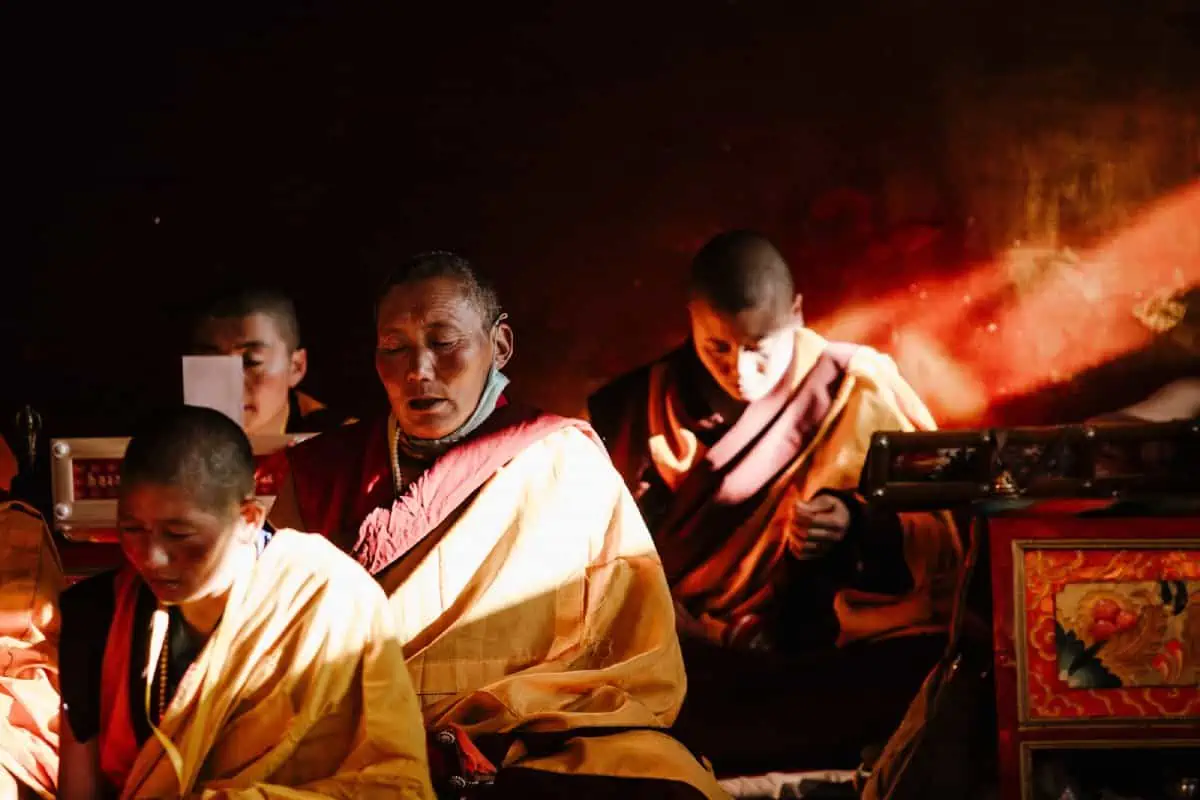If you’ve traveled in Thailand, Nepal, or other Buddhist countries, you likely observed the monks with admiration of their total zen-like attitude. You may have also visited a monastery and seen them in action, meditating with mala beads.
But what is the purpose of prayer beads in Buddhist meditation, and how does it benefit their practice?
As someone with a personal interest in Buddhism who has spent a lot of time in Thailand, I visited a monastery in Bangkok to learn more about Buddhist meditation and the use of Buddhist prayer beads.
So if Buddhism also intrigues you, here is a round-up of what I learned.
Contents
Where Do Buddhist Mala Beads Come From?
Buddhist prayer beads are a form of mala beads. Mala is a Sanskrit word that means garland, but the Tibetan word for mala is Threngwa.
It is believed that the Buddhist mala was first mentioned in a 4th-century BCE text known as Mokugenji Sutra. In this text, King Virudhaka asks the Buddha to help ease his suffering. The Buddha tells the king to recite the three jewels (the Buddha, dharma, and sangha) using a mala made of the seeds of a Sapindus (soapnut) tree.
What Do Monks Use Mala Beads For?
Prayer beads are used across many religions, including Christianity, Hinduism, and Islam. However, while a Christian would use rosary beads when praying to god, Buddhists and monks use them as counting beads to count repetitions when chanting a sacred mantra.
Alternatively, some Buddhists use the beads to count the number of breaths taken during their meditation session and help keep their minds focused on their breathing pattern.
Is It Ok To Wear Buddhist Prayer Beads?
As you’ve probably noticed, Mala beads have become a fashion statement among yogis and spiritual seekers. But is it ok to wear Buddhist prayer beads if you don’t practice Buddhism?
There is no clear-cut answer to this, as some may argue doing so is cultural appropriation. I believe it all comes down to intention. If you have no interest in meditation, yoga, or spiritual development and wear mala beads purely as a fashion accessory or jewelry, this could be seen as cultural appropriation.
However, if you use them as a tool to find focus and presence in yoga and meditation or as a reminder to practice mindfulness in your daily life, then you are using them with intention. In this case, I believe wearing them is no problem as you are using them for spiritual development as intended. Still, at the end of the day, choosing to wear mala beads is a totally personal choice.
How To Find Authentic Buddhist Mala Beads
If you decide to wear Buddhist mala beads, you should know that many modern versions sold in the western world are far from the traditional style.
Traditional Buddhist mala beads are made from simple and plain materials like seeds, bone, or wood. This represents purity and reflects the monks’ intent to remove themselves from the desires of the material world.
However, nowadays, many mala beads are made from more pretty, glamorous materials like gemstones, pearls, or lava rock. While these such beads look lovely and carry spiritual benefits, they are not authentic Buddhist prayer beads.
Aside from the material of the beads, authentic Buddhist prayer beads typically have 108 beads, representing the 108 earthly temptations a person must overcome to achieve enlightenment. These are vices that cause us suffering, like anger, arrogance, obsession, and violence, and only when we overcome them can we reach a state of nirvana.
Along with the main beads, Buddhist malas have one prominent guru bead used as the first bead and sometimes a tassel.
Top 4 Authentic Buddhist Prayer Beads
To save you from spending hours searching high and low for the best and most authentic Buddhist prayer beads, here are four of my favorites.
Hands Of Tibet Yak Bone 108 Beads Mala with Tiger Eye Spacers
These authentic Tibetan Buddhist prayer beads are handmade in Nepal using Yak Bone, symbolizing impermanence and reminding us to live in the present moment. Each bead is about 7.5mm.
In addition, you’ll find three tiger eye spacers on the mala representing strength, protection, and grounding energy. Then, the tassel comprises 6 smaller carnelian beads; carnelian has a very stabilizing power and is connected to the lower chakras.
The length of the necklace is around 35 inches, but you can adjust it by sliding the knot above the guru bead up or down.
Wonder Care Certified Rudraksha Mala Beads
This authentic and natural Buddhist mala is made from Rudraksha seeds, which grow in certain parts of South East Asia. Rudraksha seeds stabilize the nervous system and protect the wearer against negative energy, accidents, and unfortunate events. They are also known as “Tears of Shiva,” as many legends connect these seeds to Lord Shiva.
These Buddhist prayer beads are handmade in Nepal with Rudraksha seeds harvested from Indonesia. The 108 12mm, 5-face beads are sewn into a garland with a heavy-duty thread and knotted between each bead. The beads come with an authenticity certificate, pouch, and safety box.
DharmaObjects Genuine Rosewood Buddhist Prayer Beads
This Buddhist mala is made from genuine Rosewood from Mysore, India, which symbolizes kindness, compassion, and a good heart. Rosewood is also believed to improve circulation, remove obstacles, and give protection from negative energy.
The 108 beads are about 10mm in size, threaded on a 42-inch Nylon thread with three Om Mani Padme Hum silver spacer beads. Like most prayer beads, you can wear them as necklaces or multi-wrapped wrist malas on the left hand when you’re not using them in meditation.
Monk Mala Authentic 12mm Bodhi Seed Mala Prayer Beads
These Buddhist prayer beads by Monk Mala are made in Thailand, where each one has been personally blessed by a Buddhist monk. The mala is made from 108 12mm genuine Bodhi Seeds from the Bodh Gaya forest. Bodhi seeds are considered sacred to Buddhists because, as the legend goes, Buddha gained enlightenment while meditating under a Bodhi tree in the Bodh Gaya Forrest.
The mala necklace measures 58 cm in length with a simple 6-9cm double-string tassel. The beads come in a protective pouch with a certificate of authenticity from a monastery in Chiang Mai, Thailand.
How To Use Buddhist Prayer Beads
You don’t have to be a Buddhist practitioner to do mantra meditation. In fact, if you find sitting in stillness and focusing on your breath too difficult, you may find repeating mantras helps to settle your mind.
Before using mala beads in mantra meditation, you’ll need to choose your mantra. To begin with, keep it simple by chanting Om, Sat Nam, or Om Mani Padme Hum. Then, each time you repeat the mantra, touch one bead with your fingers, moving along with each repetition until you come to the end of the mala.
Here are detailed instructions for using a mala bead in mantra meditation:
- Find a comfortable seated position, take a few deep breaths, and set an intention for the meditation session. This can be a quality you want to cultivate, such as compassion, gratitude, or inner peace.
- Hold your mala with the beads draped between the middle and index fingers in your right hand.
- Place your thumb on the large guru bead and recite your first repetition.
- Do your second repetition as you slide your thumb to the next bead and pull the mala toward you.
- Do this 108 times, traveling around the entire mala. Once you reach the guru bead, you can stop chanting and take a few moments sitting in stillness, enjoying the calm and peace you have created.
Remember that you can also use prayer beads to count your breaths. The technique is the same; moving your thumb from the first bead to the next and so on with each breath.
Because prayer beads in meditation are used to build focus and presence, if you get lost, or your mind wanders, start again at the guru bead. This way, you can monitor your progress.
When you first start doing it, you might find you can only get to bead number 10. However, after a while, you will likely get much further along the mala before losing focus.
Final Thoughts On Buddhist Beads
Whether you resonate with Buddhism or not, Buddhist prayer beads can be a useful meditation tool to help keep your mind focused and present. Moreover, wearing a mala as a necklace or bracelet can help you stay connected to your spiritual path and remind you of your intention.
So if you’re looking to delve deeper into spirituality and meditation, why not give a Buddhist mala a go?



